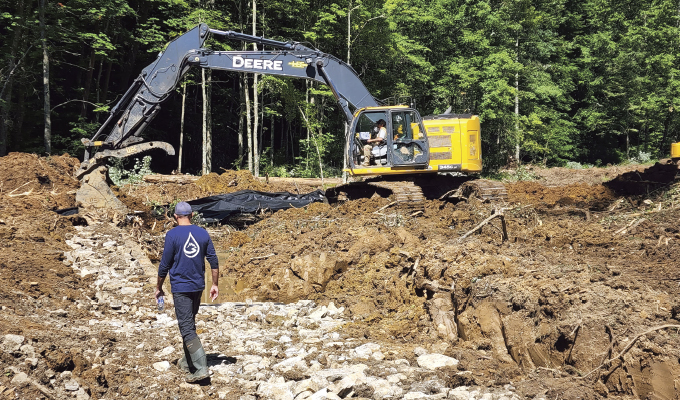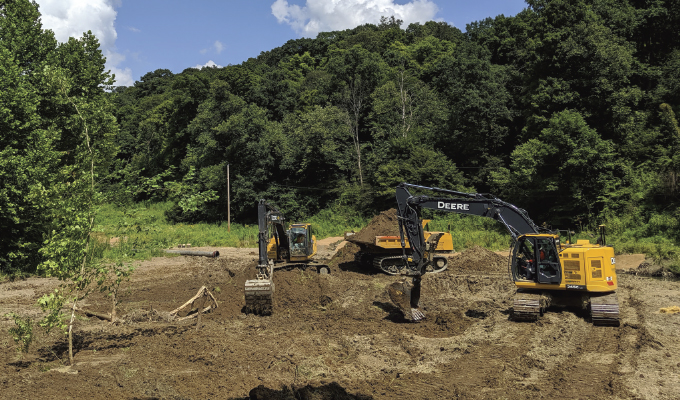It turns out you need a lot of rocks and logs to build a stream.
Robert Ross of Rosscapes, a stream and wetlands restoration company based in Canonsburg, Pennsylvania, can tell you why: “Building a stream is all about precision and accuracy. We use large rocks and logs that need to be fitted together precisely to ensure a successful project. You need to fit the puzzle together.” With nearly 20 years of experience across the Appalachian region, Ross is no longer puzzled as to which equipment is best suited to this unique task.
THE FLEET
He’s amassed quite a fleet including 20 John Deere excavators of various sizes, each fitted with Topcon GPS/LPS capabilities; a Werk-Brau coupler and Progressive Link thumb, an assortment of Werk-Brau buckets; seven Morooka rubber tracked carriers, four of which were custom built; John Deere compact track loaders, Komatsu D51pxi precision grade dozers and pumps from 4- to 12-inches; along with plenty of hose, straw blowers, and more, as well as enough haul trucks to move it all. Surprisingly, only the Morookas are custom-built for his business—the rest of his fleet is equipment that’s readily available. What sets Ross apart is how he employs it. This talent has led his company to contract with, over the years, everyone from oil and gas companies to coal mining companies to government departments of transportation to private mitigation banking companies. There’s three pieces of equipment Rosscapes needs to move the multi-ton boulders it can encounter on an average job: Werk-Brau’s Progressive Linkage Thumb, Heavy Duty Excavator Bucket, and D-Link Coupler. Each component works together to ensure the Rosscapes crew can safely and precisely move rocks, logs, and tree brush for over eight hours a day.
In terms of excavators, Ross uses John Deere machines across the board. His company’s smallest is a 50G compact excavator, and their largest is a John Deere 345G. For stream restoration, Rosscapes utilizes 160G and 210G LC Mid-Size Excavators, but its “go-to” is its fleet of seven 245G’s. Ross usually purchases machines from either Murphy Tractor & Equipment Company, or Leslie Equipment Company.

TYPICAL PROJECT SCOOPE
A typical job for Rosscapes lasts, on average, between six and eight months, but the company has had projects be as short as three and as long as twelve. The employees have the system down pat: After building lay-down areas around the stream, workers use pumps to redirect the flow of the stream reach they’re working on.
Then they clear trees and brush out of the way, before sending in someone to move and excavate the rocks that make up the stream. If they push over trees, they’ll use the root wads as well, and save the brush for other applications. Over the course of each day, the excavators are removing trees, moving soil and rock, and rebuilding stream beds. Finally, after a section of stream has been restored, the team puts down erosion control matting and lays grass seed and straw, then finally returns the flow of the stream to its original direction. Because they are reseeding roughly 150-foot sections of reach at a time, they usually have two people broadcast seed and then shake straw by hand. They may go through 15 bales of straw, but they can cover that amount of ground in the time it would take to fetch the straw blower. Each section is cleaned up as they go, so that most sections are already growing by the time the final section is competed. This approach reduces erosion and sedimentation during the construction process.
Rosscapes can build between one hundred and 150 feet of stream in a day. The Progressive Link Thumbs, Ross says, allow his workers to place rocks precisely where they’re needed, even if the buckets they use for moving earth are in a full dump position. “Once we bought our first Progressive Link Thumb, I haven’t not bought one since,” says Ross.
He especially appreciates how the linkage is integrated and collapsible, allowing the thumb to close further—providing a full 180-degree range of motion. He also likes that they utilize wear-resistant and high-strength steel in critical components and have induction-hardened pivot pins and cylinder rods to improve durability. A rigid skeletal structure increases torsion resistance, and because every thumb includes Werk-Brau’s Universal Linkage Pivot System, Ross can easily install them on any excavator arm in his fleet.

HEAVY-DUTY MOVING
Since stream restoration can involve moving thousands of tons of dirt and rocks out of the way, Ross needs buckets that can withstand the pressure and weight of both materials.
“When we first started, we had other manufacturers’ buckets, and we were blowing the bottoms of them in. They were denting up from hitting these rocks,” says Ross. “Then we went to Werk-Brau, and we really haven’t had that trouble.”
It’s easy to see why. Werk-Brau’s Heavy Duty Excavator Buckets have horizontal wear stripes to protect the bottom and are made with high-strength T-1 steel on all high wear parts. These features, combined with tapered side plates and a dual-taper radius, allow Rosscapes crews to handle the diverse range of applications, like huge boulders and logs, they might encounter on a jobsite. In fact, Werk-Brau’s buckets have lasted twice as long, says Ross, as their competitors.
Some of the rocks, he says, weigh between five and six tons each, while the logs can be up to 70 feet long. With his Progressive Linkage Thumbs and Heavy-Duty Buckets, Ross doesn’t have to fear dropping a log while restoring important wetlands and creeks, “They are also strong enough to handle the long logs and trees.” If Ross’ crew grabs, for example, a 60-foot-long tree, it can stick out 30 feet on either side of the bucket. “Some competitors’ thumbs we had started twisting and breaking the welds off the boom,” Ross says. “Ever since we went to the Werk-Brau, we really haven’t had any trouble at all.”
Plus, Rosscapes prefers toothed buckets rather than smooth-edged ones because they can “rake the dirt with our teeth so it leaves it clumpy and humpy and bumpy.” That “microtopography” on the flood plain around a stream, says Ross, helps to slow down flooding and encourages the growth of the different grass seeds Rosscapes uses. In other words, the toothed edge gives the area being restored a more diverse plant population.

SAFETY IN DESIGN
Ross like the simple coupler design—with just six components there is less to wear out or break down. Easy installation with no greasing or lubrication required is another plus. But he most appreciates that they are designed with safety in mind: The automatic front lock holds the front pin in place if the rear is not secured as well. It will only release when the operator intends it to.
Ross usually pulls his equipment out of stream application once it reaches between 3,000 and 4,000 hours in use, while the seals are strong and leaks are non-existent.
Together, Werk-Brau’s Progressive Linkage Thumb, Heavy Duty Excavator Buckets, and D-Link Coupler allow Ross and his crew to restore streams and wetlands up and down the Appalachian region. The quality of their work, Ross says, has given them a solid reputation in the area for almost two decades. Thanks to Werk-Brau attachments for the equipment, Rosscapes can continue to give its clients the high-quality results they need.
CLOSING THOUGHT
A puzzle is only complete once all pieces have been fitted precisely into place. Rosscapes has built a solid reputation in the Appalachian region through the work it’s done over 20 years. Having the right equipment is crucial—like a puzzle, if one piece is missing or wrong, the entire project can fall apart.
About the Author:
Werk-Brau manufactures a complete line of OEM and replacement attachments for excavators, mini excavators, backhoes, mini and full-size loaders, and crawler loaders. Since 1947, they have been industry leading innovators, designing, and producing standard and specialty products for the heavy equipment industry. Products are made in the USA and sold through equipment dealers and distributors worldwide. For more, visit www.werk-brau.com.
Modern Contractor Solutions, January 2024
Did you enjoy this article?
Subscribe to the FREE Digital Edition of Modern Contractor Solutions magazine.



